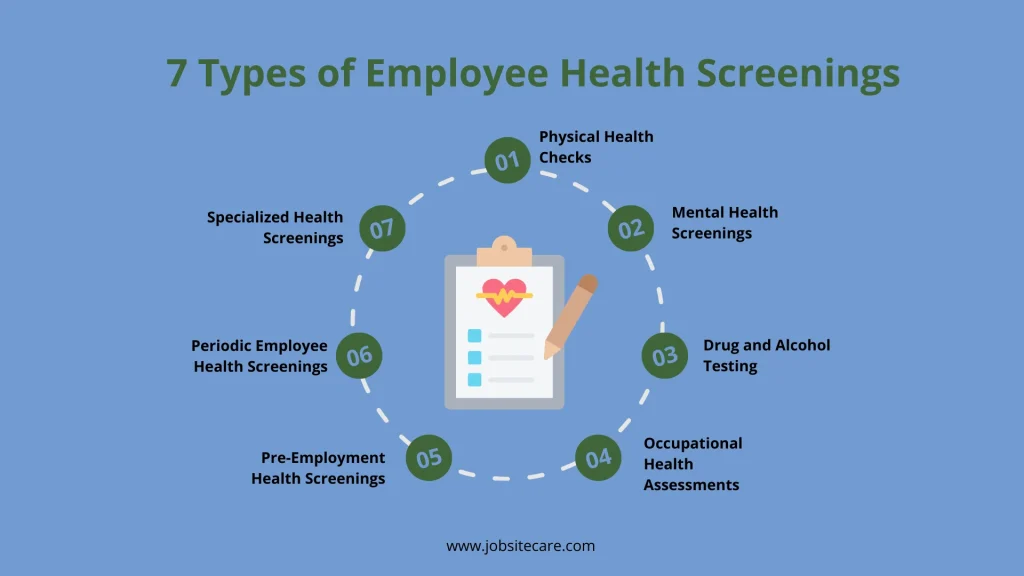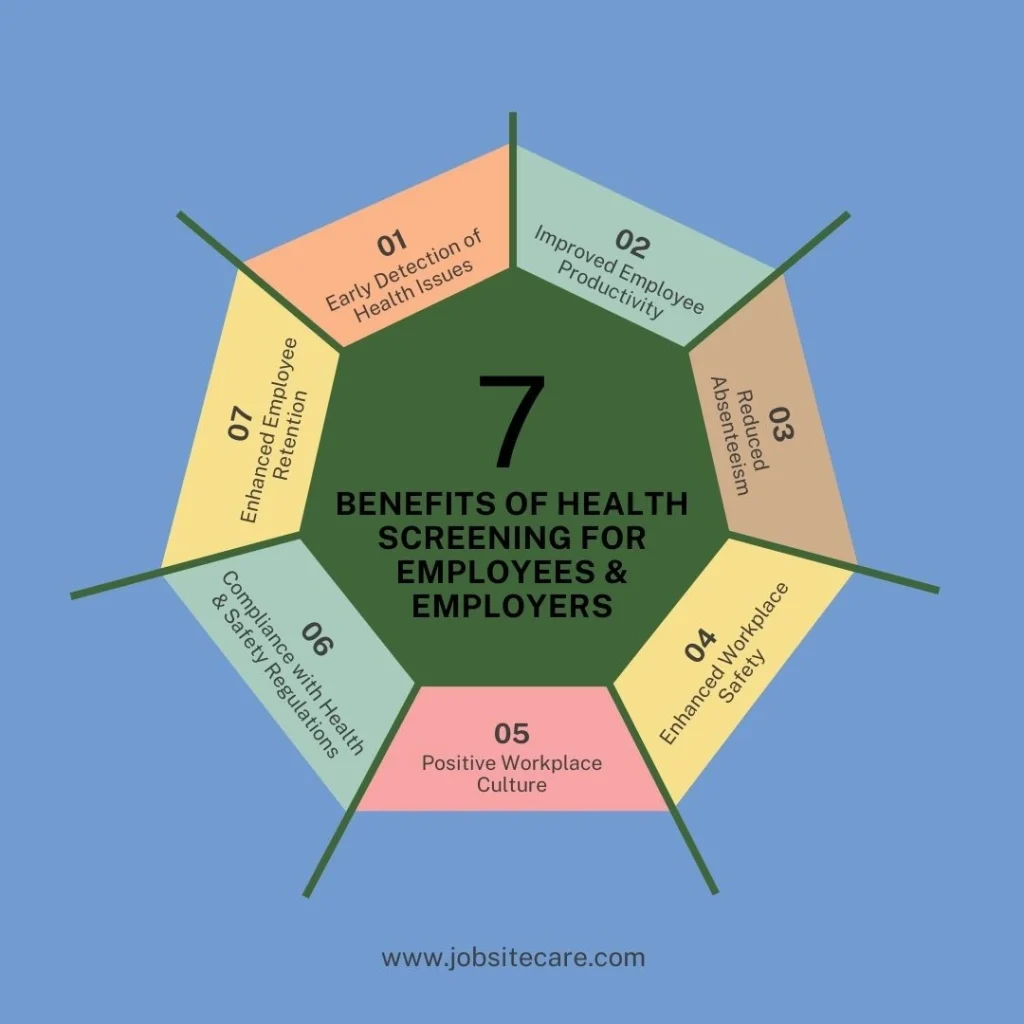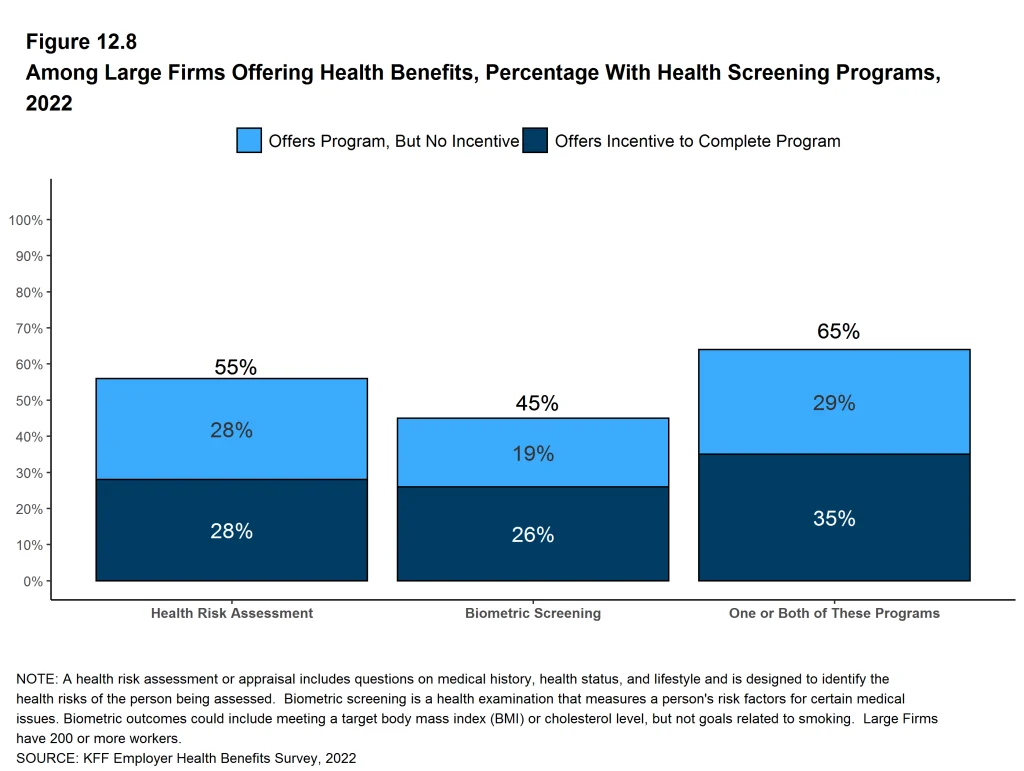Regular employee health screening at work creates stronger, healthier organizations. Companies that invest in employee wellness programs see significant returns – according to a Harvard study, every dollar spent on wellness programs reduces medical costs by $3.27 and absenteeism costs by $2.73. Employee health screening programs help organizations identify potential health issues early while creating a culture of wellness and prevention.
These screenings serve as an essential tool for maintaining workplace health and safety. They help reduce employee absences, increase productivity, and ensure workers can perform their jobs safely and effectively. Through proactive health screenings, organizations demonstrate their commitment to employee wellbeing while building a more resilient workforce.
What Is Employee Health Screening and Why Is It Important?
Employee health screening is regular medical assessments and health checks to evaluate workers’ physical and mental wellbeing. These screenings help identify potential health risks before they become serious issues. They include various tests and assessments tailored to specific job requirements and workplace conditions.
The importance of employee health screening continues to grow as workforce expectations evolve. Today’s employees expect comprehensive support for their wellbeing from their employers. This shift in expectations is shown in the numbers – 70% of workers believe their employers should provide mental and emotional health programs.
This is how health screenings create a win-win situation:
- Employees benefit from early detection of health issues when treatment works best.
- Employers see reduced healthcare costs, fewer absences, and safer workplaces.
Plus, these programs help organizations meet their legal requirements for workplace safety and employee health protection.
A good health screening program looks at your specific workplace needs. It combines basic employee health checks with targeted screenings based on job risks and demands. This focused approach ensures everyone gets the right health evaluations while your organization uses resources efficiently.
7 Types of Employee Health Screenings
Organizations can offer several types of health screenings to support employee health, wellbeing and workplace safety. Each type serves a specific purpose and adds value to both employees and employers.

1. Physical Health Checks
Physical health checks evaluate if employees can safely perform their work duties. These screenings include basic health measurements:
- Blood pressure tests
- Cholesterol screening
- Body mass index (BMI) calculations
Medical professionals perform these tests to find early signs of health conditions like heart disease or diabetes. The results help employees understand their health status and guide them toward any needed medical care.
2. Mental Health Screenings
Mental health screenings look for signs of stress, anxiety, depression, and burnout in the workplace. These screenings matter because mental health issues cost U.S. employers $193 billion each year in lost productivity. The screening process includes private conversations with healthcare providers who can recommend support services when needed.
3. Drug and Alcohol Testing
Drug and alcohol testing keeps workplaces safe. Companies that use drug testing programs have 51% fewer workplace accidents. The testing follows specific steps to ensure accurate results and protect employee privacy. This type of screening prevents common workplace injuries and helps maintain a safe environment for all workers.
4. Occupational Health Assessments
Occupational health assessments check if workers can handle their specific job duties safely. These workplace screenings look at both physical and mental job requirements. For example, employees who sit at desks receive ergonomic assessments, while those working with chemicals get respiratory health checks. Organizations that prioritize workplace injury management through regular occupational health assessments see workplace injuries decrease by 25%
5. Pre-Employment Health Screenings
Pre-employment health screenings help ensure new employees can safely perform their jobs. These employee health checks include vision and hearing tests, physical ability assessments, and medical history reviews. The screening results help protect both the new employee and their coworkers by confirming they can handle job tasks safely.
6. Periodic Employee Health Screenings
Regular health screenings for employees track changes in worker health over time. Staff health screenings identify new health concerns before they become serious problems. These ongoing checks prove especially important for employees in physically demanding jobs or those who have worked at the company for many years.
7. Specialized Health Screenings
Different jobs need different types of health screening for work, especially in environments with unsafe working conditions. Construction workers might need lung function tests due to dust exposure. Healthcare workers require screenings for infectious diseases. These targeted employee health checks protect workers from specific job hazards. The screenings match the exact health risks workers face in their daily tasks.
The Benefits of Health Screening for Employees and Employers

Employee health screening programs provide clear advantages for both workers and organizations. These benefits improve workplace safety, employee wellbeing, and business operations.
1. Early Detection of Health Issues
Employee health screenings find potential health problems early and when workers discover health issues sooner, they can get treatment faster. Organizations benefit because workers need less time off for medical treatment. Early health screening for employees also reduces the costs of treating advanced health problems. Actually, health screenings for employees result in 26% percent lower healthcare costs.
2. Improved Employee Productivity
When employees maintain good health, their job performance naturally improves. Health screening programs identify and address potential issues before they impact work quality, leading to a more productive and efficient workplace environment.
3. Reduced Absenteeism
Concrete research demonstrates the powerful impact of employee health screening programs on workplace attendance. Organizations implementing these programs experience measurable improvements: sick leave and absenteeism drop by 28%.
4. Enhanced Workplace Safety
Staff health screening programs prevent accidents by making sure workers can safely do their jobs. The screenings check if employees can handle physical tasks without risking injury. Organizations that prioritize health screenings see worker’s compensation claims reduce by 30%.
5. Positive Workplace Culture
Health screening programs show employees their wellbeing matters. When organizations invest in employee health checks, workers feel valued. This investment builds trust between employers and employees
6. Compliance with Health and Safety Regulations
Health screening for employees helps organizations meet legal safety requirements. These programs ensure businesses follow workplace health rules, especially in industries with strict safety standards. Following these requirements prevents fines and legal issues while protecting the organization’s reputation.
7. Enhanced Employee Retention
Organizations that prioritize employee health screening create stronger bonds with their workforce. These health programs demonstrate a clear commitment to worker wellbeing, which builds loyalty over time. As a result, employees choose to stay with companies that invest in their health through comprehensive screening programs, reducing the significant costs associated with recruitment and training.
How to Implement an Effective Employee Health Screening Program
Employee health screening programs need careful planning to succeed. Here’s how to create an effective workplace health screening system that protects your workers and supports your business.

1. Assess Workplace Health Needs
Every workplace needs different types of health screening for employees. Construction sites, for example, face specific challenges like heavy lifting risks, heat exposure, and equipment safety. A thorough workplace assessment looks at all these factors to create the right health screening approach. JobSiteCare helps organizations identify these specific needs and develops targeted health solutions that work for each unique workplace.
2. Select a Qualified Health Screening Provider
Finding the right partner for your staff health screening program makes a big difference. Look for a provider who understands workplace safety issues and health risks in your industry. We bring this expertise through services like on-site medical teams and 24/7 occupational telemedicine. These services help workers get quick access to care while keeping the workplace running smoothly.
3. Develop a Customized Screening Program
Your employee health screening program should match your workplace needs. This means including the right mix of health checks for your workers. For example, machinery operators might need regular balance and vision screenings, while outdoor workers need skin cancer checks. JobSiteCare creates these custom health screening programs to protect workers while supporting your company’s safety goals.
4. Ensure Compliance with Regulations
Workplace health screenings must follow safety and privacy rules. This means protecting worker health information (through HIPAA rules) and meeting workplace safety requirements (through OSHA standards). JobSiteCare’s expertise keeps your health screening program within these rules while protecting your workers’ private information.
5. Communicate the Program to Employees
Staff health screening programs work best when employees understand their value. Many workers have questions about workplace health checks and privacy. We create clear messages about how health screenings protect workers’ wellbeing. This open communication helps employees feel comfortable participating in the program.
6. Schedule and Conduct Screenings
Employee health screening should fit naturally into the workday. We bring medical teams directly to your workplace and offer remote doctor visits through video calls. This means workers can complete their health checks without long breaks or travel time. Our flexible scheduling keeps projects on track while ensuring every worker receives proper health screening for work.
7. Follow Up and Provide Support
Finding health issues through screening is just the first step. Workers need clear guidance and support after their health checks. JobSiteCare connects workers with the right care, whether that means seeing specialists or following specific treatment plans.
8. Monitor and Adjust the Program
Regular review of your employee health screening program ensures it continues to meet workplace needs. Track how well the program prevents injuries and protects worker health. We provide detailed reports and insights that help improve your health screening program over time. These insights help make your health screening program better match your changing workplace needs.
Conclusion
When organizations invest in health screening for employees, they see real results. Beyond ensuring safety in the workplace and catching health issues early, these programs build a stronger, more productive workforce. Your employees will know their health matters, creating a workplace where people want to stay and give their best.
JobSiteCare puts effective workplace health screening within your reach. We understand every workplace faces unique challenges – that’s why we design staff health screening programs that fit your specific needs. From bringing medical teams to your site to offering quick video calls with doctors, we make worker health protection straightforward and effective.
Ready to see the difference employee health screening can make? Take our quick risk assessment quiz to understand your workplace needs.
For complete workplace protection, explore our Injury Management Services – your solution for comprehensive workplace safety and end-to-end injury management.
Contact us today and let’s build a healthier workplace together.
Frequently Asked Questions About Employee Health Screening
1. How can health screenings benefit high-risk industries like construction?
Employee health screening programs in construction help prevent workplace injuries by checking workers’ ability to perform physical tasks safely. These screenings identify potential health risks specific to construction work, like musculoskeletal problems or heat stress issues. Regular health screening for employees in construction reduces worker’s compensation claims and keeps projects running safely.
2. How often should health screenings be conducted for employees?
Staff health screenings should happen at different intervals based on workplace risks and job duties. Most organizations conduct annual health checks for all workers. However, employees in high-risk positions might need quarterly screenings, while those handling hazardous materials require monthly checks. New employees should complete pre-employment screenings before starting work.
3. What is the role of telemedicine in employee health screening programs?
Workplace health screening through telemedicine provides quick access to medical professionals without disrupting work schedules. Workers can connect with doctors through video calls for initial assessments, follow-up care, and health consultations. This makes employee health screening more convenient and helps workers get medical advice when they need it.
4. Are pre-employment health screenings different from regular screenings?
Yes, health screening for work during pre-employment focuses on ensuring new hires can safely perform their job duties. These screenings check specific job-related health requirements and establish baseline health information. Regular employee health screenings, in contrast, track changes in worker health over time and focus on preventing work-related health issues.
5. How should employers handle health screening records and ensure privacy?
Employers must keep employee health screening records confidential and separate from general personnel files. All health information should be stored in secure, HIPAA-compliant systems with restricted access. Only authorized medical professionals should handle detailed health information, while employers receive only job-related fitness information.
6. How do employee health screenings help reduce workplace accidents?
Health screening for employees prevents accidents by ensuring workers are physically able to perform their jobs safely. Regular screenings identify fatigue, health conditions, or physical limitations that could lead to accidents. Companies that implement workplace health screening programs see fewer injuries and accidents because they catch potential problems early.


